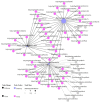Transcriptome Analysis of the Cf-13-Mediated Hypersensitive Response of Tomato to Cladosporium fulvum Infection
- PMID: 35563232
- PMCID: PMC9102077
- DOI: 10.3390/ijms23094844
Transcriptome Analysis of the Cf-13-Mediated Hypersensitive Response of Tomato to Cladosporium fulvum Infection
Abstract
Tomato leaf mold disease caused by Cladosporium fulvum (C. fulvum) is one of the most common diseases affecting greenhouse tomato production. Cf proteins can recognize corresponding AVR proteins produced by C. fulvum, and Cf genes are associated with leaf mold resistance. Given that there are many physiological races of C. fulvum and that these races rapidly mutate, resistance to common Cf genes (such as Cf-2, Cf-4, Cf-5, and Cf-9) has decreased. In the field, Ont7813 plants (carrying the Cf-13 gene) show effective resistance to C. fulvum; thus, these plants could be used as new, disease-resistant materials. To explore the mechanism of the Cf-13-mediated resistance response, transcriptome sequencing was performed on three replicates each of Ont7813 (Cf-13) and Moneymaker (MM; carrying the Cf-0 gene) at 0, 9, and 15 days after inoculation (dai) for a total of 18 samples. In total, 943 genes were differentially expressed, specifically in the Ont7813 response process as compared to the Moneymaker response process. Gene ontology (GO) classification of these 943 differentially expressed genes (DEGs) showed that GO terms, including "hydrogen peroxide metabolic process (GO_Process)", "secondary active transmembrane transporter activity (GO_Function)", and "mismatch repair complex (GO_Component)", which were the same as 11 other GO terms, were significantly enriched. An analysis of the Kyoto Encyclopedia of Genes and Genomes (KEGG) revealed that many key regulatory genes of the Cf-13-mediated resistance response processes were involved in the "plant hormone signal transduction" pathway, the "plant-pathogen interaction" pathway, and the "MAPK signaling pathway-plant" pathway. Moreover, during C. fulvum infection, jasmonic acid (JA) and salicylic acid (SA) contents significantly increased in Ont7813 at the early stage. These results lay a vital foundation for further understanding the molecular mechanism of the Cf-13 gene in response to C. fulvum infection.
Keywords: Cf-13 gene; Cladosporium fulvum; RNA-seq; Solanum lycopersicum; resistance response.
Conflict of interest statement
The authors declare no conflict of interest.
Figures










Similar articles
-
Transcriptome profiling reveals the response process of tomato carrying Cf-19 and Cladosporium fulvum interaction.BMC Plant Biol. 2019 Dec 19;19(1):572. doi: 10.1186/s12870-019-2150-y. BMC Plant Biol. 2019. PMID: 31856725 Free PMC article.
-
Physiological and RNA-seq analyses provide insights into the response mechanism of the Cf-10-mediated resistance to Cladosporium fulvum infection in tomato.Plant Mol Biol. 2018 Mar;96(4-5):403-416. doi: 10.1007/s11103-018-0706-0. Epub 2018 Jan 30. Plant Mol Biol. 2018. PMID: 29383477
-
Comparative transcriptome analysis reveals the response mechanism of Cf-16-mediated resistance to Cladosporium fulvum infection in tomato.BMC Plant Biol. 2020 Jan 20;20(1):33. doi: 10.1186/s12870-020-2245-5. BMC Plant Biol. 2020. PMID: 31959099 Free PMC article.
-
Recognitional specificity and evolution in the tomato-Cladosporium fulvum pathosystem.Mol Plant Microbe Interact. 2009 Oct;22(10):1191-202. doi: 10.1094/MPMI-22-10-1191. Mol Plant Microbe Interact. 2009. PMID: 19737093 Review.
-
Molecular interactions between tomato and the leaf mold pathogen Cladosporium fulvum.Annu Rev Phytopathol. 2005;43:395-436. doi: 10.1146/annurev.phyto.43.040204.140224. Annu Rev Phytopathol. 2005. PMID: 16078890 Review.
Cited by
-
Comparison of Tomato Transcriptomic Profiles Reveals Overlapping Patterns in Abiotic and Biotic Stress Responses.Int J Mol Sci. 2023 Feb 17;24(4):4061. doi: 10.3390/ijms24044061. Int J Mol Sci. 2023. PMID: 36835470 Free PMC article.
-
Beyond the genomes of Fulvia fulva (syn. Cladosporium fulvum) and Dothistroma septosporum: New insights into how these fungal pathogens interact with their host plants.Mol Plant Pathol. 2023 May;24(5):474-494. doi: 10.1111/mpp.13309. Epub 2023 Feb 15. Mol Plant Pathol. 2023. PMID: 36790136 Free PMC article. Review.
-
RNA-Seq Analysis Demystify the Pathways of UV-A Supplementation in Different Photoperiods Integrated with Blue and Red Light on Morphology and Phytochemical Profile of Kale.Antioxidants (Basel). 2023 Mar 16;12(3):737. doi: 10.3390/antiox12030737. Antioxidants (Basel). 2023. PMID: 36978985 Free PMC article.
-
Physiological and transcriptome profiling revealed defense networks during Cladosporium fulvum and tomato interaction at the early stage.Front Plant Sci. 2022 Dec 6;13:1085395. doi: 10.3389/fpls.2022.1085395. eCollection 2022. Front Plant Sci. 2022. PMID: 36561446 Free PMC article.
References
-
- Van Eck J., Kirk D.D., Walmsley A.M. Tomato (Lycopersicum esculentum) Methods Mol. Biol. 2006;343:459–473. - PubMed
MeSH terms
Substances
Supplementary concepts
Grants and funding
- 32072589/National Natural Science Foundation of China
- 32102390/National Natural Science Foundation of China
- CARS-23-A11/The China Agriculture Research System
- 2019ZX16B02/"hundred and ten million" project science and technology major special subject of Heilongjiang Province
- LBH-Z19046/Postdoctoral science foundation of heilongjiang province
LinkOut - more resources
Full Text Sources
Miscellaneous

